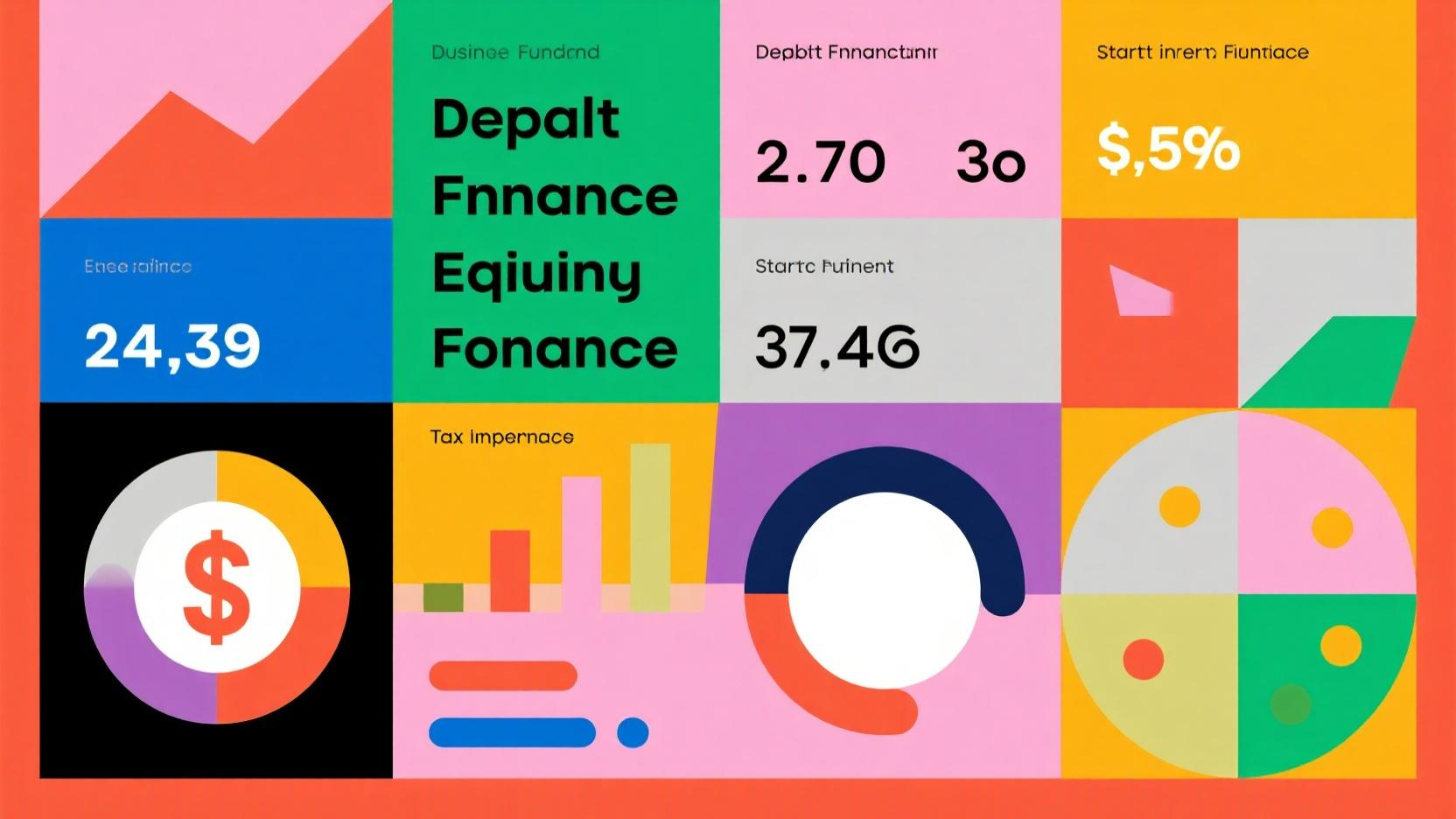
Image Source: pexels
Choosing the right financing option can significantly influence a business’s trajectory. Financing decisions play a crucial role in shaping growth, profitability, and long-term stability. For example:
- Global bond issuance surged by 13% in early 2024, with projections indicating a 9% increase for the year.
- Many borrowers are turning to refinancing strategies to navigate market uncertainties.
This brings us to an essential topic: Equity Financing vs Debt Financing: Comparative Analysis. Understanding the key differences between these two financing methods is vital in determining which option aligns best with your business needs.
Key Takeaways
- Debt financing lets businesses borrow money but keep ownership. This is good for those wanting to stay in control.
- Equity financing gives freedom without needing to pay back money. It helps startups grow and gain advice from investors.
- Picking debt or equity financing depends on your business needs. Check your money flow and risks before deciding.
Debt Financing

Image Source: pexels
Definition
Debt financing refers to the process of raising capital by borrowing funds from external sources, such as banks, financial institutions, or private lenders. Businesses agree to repay the borrowed amount, often with interest, over a specified period. This method allows companies to access funds without diluting ownership. Studies, such as those by Margaritis and Psillaki (2010), highlight that debt financing can positively impact profitability when managed effectively.
| Study | Findings | Link |
|---|---|---|
| Margaritis and Psillaki (2010) | Found a positive relationship between debt and profitability. | Link |
| Ezeoha (2008) | Found that debt-taking negatively affects profitability in some cases. | Link |
Types
Debt financing comes in various forms, each catering to different business needs:
- Term Loans: Fixed amounts borrowed for a specific purpose, repayable over a set period.
- Lines of Credit: Flexible borrowing options allowing businesses to withdraw funds as needed.
- Bonds: Long-term debt instruments issued to investors, often used by larger corporations.
- Invoice Financing: Short-term borrowing against unpaid invoices to improve cash flow.
The commercial lending market, projected to grow from $14.15 trillion in 2023 to $16.44 trillion in 2024, underscores the increasing reliance on debt financing across industries.
Key Features
Debt financing offers several distinct characteristics:
- Ownership Retention: Borrowers retain full control of their business, unlike equity financing.
- Fixed Repayment Terms: Loans come with predetermined repayment schedules, ensuring clarity.
- Tax Benefits: Interest payments on debt are often tax-deductible, reducing overall tax liability.
- Risk of Default: Failure to meet repayment obligations can lead to financial distress or bankruptcy.
| Key Feature | Evidence |
|---|---|
| Impact of debt on profitability | Total debt to assets and interest coverage has a positive relationship with profitability. |
| Trade-offs in capital structure | Managers set target debt ratios to balance benefits and costs, such as tax advantages and bankruptcy costs. |
| Influence of capital structure theories | Different studies support various capital structure theories based on specific circumstances. |
Debt financing continues to play a pivotal role in business growth strategies. The private debt market, which grew from $575 billion in 2019 to $848 billion by 2020, is expected to reach nearly $1.5 trillion by 2025, reflecting its importance in modern financial planning.
Equity Financing
Definition
Equity financing involves raising capital by selling shares of a business to external investors. This process allows businesses to secure funds without incurring debt. In exchange for their investment, external parties receive ownership stakes in the company. This method is particularly beneficial for small businesses that lack immediate cash reserves. It provides them with the financial resources needed to expand operations or develop new products. The private equity sector’s rapid growth, projected to manage nearly $6 trillion in assets by 2025, highlights the increasing reliance on equity financing in the business world.
Types
Equity financing offers various options tailored to the needs of startups and established companies:
- Public Equity: Businesses raise funds by offering shares to the public through stock exchanges.
- Private Equity: Companies secure investments from private equity firms or individual investors.
- Seed Capital: Early-stage funding provided by angel investors or seed capital firms to help startups launch.
- Venture Capital: Investments made by venture capital firms in high-growth potential startups.
A study on financing rounds reveals that strong financial backing from existing equity investors increases the likelihood of securing venture loans. This interconnectedness demonstrates the strategic importance of equity financing for startups.
Key Features
Equity financing provides unique advantages that set it apart from debt financing:
- No Repayment Obligation: Unlike loans, equity financing does not require repayment, reducing financial strain.
- Shared Risk: Investors share the business’s risks and rewards, aligning their interests with the company’s success.
- Access to Expertise: Equity investors often bring valuable industry knowledge and networks to the table.
- Dilution of Ownership: While businesses gain capital, they must share control and profits with investors.
Equity financing plays a pivotal role in the “Equity Financing vs Debt Financing:Comparative Analysis,” offering businesses a flexible and growth-oriented funding option.
Pros and Cons of Debt Financing
Advantages
Debt financing offers several compelling benefits for businesses seeking funding. One of the most significant advantages is ownership retention. Borrowers maintain full control of their company, as lenders do not acquire equity or voting rights. This allows entrepreneurs to make decisions independently, preserving their vision for the business.
Another advantage lies in the tax benefits. Interest payments on debt are often tax-deductible, reducing the overall tax burden. This feature makes debt financing a cost-effective option for many businesses. Recent studies reveal a positive correlation between total debt to assets and interest coverage with profitability. This indicates that businesses leveraging interest-based debts can achieve higher profits when managed effectively.
Debt financing also provides predictability. Fixed repayment schedules allow businesses to plan their finances with clarity. This structured approach ensures that companies can allocate resources efficiently without unexpected financial surprises.
Disadvantages
Despite its advantages, debt financing comes with notable drawbacks. The obligation to repay loans, regardless of business performance, creates financial pressure. Companies must meet repayment deadlines, which can strain cash flow during challenging periods.
Empirical data highlights additional risks:
- The Pakistan Stock Exchange study shows that debt financing negatively impacts return on equity, though it positively affects return on assets (ROA).
- Research by Akinlo and Asaolu (2012) found that increased debt correlates with decreased profitability for Nigerian firms.
- Short-term debt obligations heighten the risk of insolvency and financial distress more than long-term commitments.
These findings underscore the potential dangers of over-reliance on debt. Businesses must carefully assess their repayment capacity and financial stability before opting for this financing method.
Debt financing remains a critical component of the “Equity Financing vs Debt Financing: Comparative Analysis.” However, its suitability depends on a company’s financial health and long-term goals.
Pros and Cons of Equity Financing
Advantages
Equity financing offers several compelling benefits, particularly for businesses seeking growth without the burden of debt repayment. Unlike loans, equity financing does not require monthly payments, allowing companies to maintain cash flow and allocate more resources toward expansion. This flexibility is especially advantageous for startups and small businesses that may lack the financial stability to handle debt obligations.
Another significant advantage lies in the absence of collateral requirements. Businesses can secure funding without undergoing strict creditworthiness assessments, enabling them to focus on innovation and scaling operations. Equity financing also fosters valuable connections. Networking and pitching to investors often lead to mentorship opportunities and access to industry expertise, which can accelerate a company’s growth trajectory.
In high market conditions, equity financing allows businesses to leverage their equity for transactions without incurring the costs associated with debt. This approach provides a strategic edge, particularly in industries with rapid growth potential. Moreover, equity investors share the risks and rewards of the business, aligning their interests with the company’s success.
Tip: Companies seeking long-term growth and strategic partnerships often find equity financing to be a more sustainable option than debt financing.
Disadvantages
Despite its benefits, equity financing comes with notable drawbacks. Businesses must share ownership with investors, which can dilute control over decision-making. Investors often seek a say in management, potentially hindering the founder’s ability to execute their vision. Additionally, profits must be shared with equity holders, extending beyond the initial investment.
The process of securing equity financing can also be time-consuming. Finding suitable investors and negotiating terms may take months, delaying critical business initiatives. Valuations in high-growth or uncertain industries pose another challenge. Companies risk undervaluing their equity, which can lead to unfavorable deals.
Equity financing also impacts existing shareholders. Issuing new shares dilutes their holdings, reducing the value of individual shares. This dilution can create tension among stakeholders, particularly in businesses with a strong focus on shareholder returns.
While equity financing provides flexibility and growth opportunities, it requires careful consideration of its long-term implications. Businesses must weigh the trade-offs between shared ownership and financial freedom to determine if this approach aligns with their goals.
Equity Financing vs Debt Financing: Comparative Analysis
Ownership and Control
Ownership and control differ significantly between equity and debt financing. Equity financing requires businesses to issue shares, which dilutes ownership. Investors gain a say in decision-making, potentially altering the original vision of the founders. On the other hand, debt financing allows owners to retain full control. Borrowers do not give up ownership but must adhere to repayment schedules and financial covenants.
- Equity financing dilutes ownership and introduces shared decision-making.
- Debt financing retains ownership but imposes repayment obligations.
This trade-off makes debt financing appealing to those prioritizing control, while equity financing suits businesses seeking collaborative growth.
Financial Obligations
Debt financing creates fixed repayment obligations, regardless of business performance. This predictability can strain cash flow during downturns. However, interest payments are tax-deductible, offering a financial advantage. Equity financing, in contrast, does not require repayment. Businesses gain flexibility but must share profits with investors.
| Aspect | Debt Financing | Equity Financing |
|---|---|---|
| Repayment Obligations | Fixed repayments regardless of performance | No fixed obligations, more cash flow flexibility |
| Tax Benefits | Interest is tax-deductible | No tax benefits, potential dilution of ownership |
| Impact on Ownership | Does not dilute ownership | Dilutes ownership and control |
Debt financing suits businesses with stable cash flow, while equity financing benefits those prioritizing flexibility.
Risk and Reward
Debt financing carries the risk of default, especially during financial downturns. Businesses must meet repayment deadlines, which can lead to insolvency if cash flow falters. However, the reward lies in retaining full ownership. Equity financing spreads risk among investors. While this reduces financial strain, it also dilutes ownership and profits.
Choosing between these options depends on a company’s risk tolerance and growth strategy. Debt financing offers higher rewards for those confident in their financial stability. Equity financing provides a safety net for businesses navigating uncertainty.
Tax Implications
Tax benefits differ between equity and debt financing. Interest payments on loans are tax-deductible, reducing taxable income and providing a financial cushion. Dividend payments to equity investors, however, are not tax-deductible.
- Debt financing offers a tax shield through deductible interest payments.
- Equity financing lacks tax benefits, impacting profitability.
| Financing Type | Tax Implications | Impact on Profitability |
|---|---|---|
| Equity Financing | No tax benefits | Dilutes existing shareholders’ holdings |
| Debt Financing | Interest payments are tax-deductible | Reduces taxable income |
Businesses seeking to optimize tax savings often lean toward debt financing.
Long-Term Impact
The long-term impact of financing decisions shapes a company’s future. Debt financing increases leverage ratios, which can limit future borrowing capacity. However, it preserves ownership and control. Equity financing fosters growth without repayment pressure but dilutes ownership and profits.
Strategic planning is essential. Businesses must weigh the benefits of ownership retention against the flexibility of equity financing. The right choice depends on long-term goals and financial health.
Choosing Between Debt and Equity Financing
Scenarios Favoring Debt Financing
Debt financing works best for businesses with predictable cash flows and strong financial stability. Companies that prioritize ownership retention often choose this option. Borrowers maintain full control while meeting fixed repayment schedules.
- Case Study: Central Japan Railway
- The company needed ¥1.6 trillion ($16 billion USD) for a new railroad line.
- Equity funding would dilute ownership significantly, representing 43% of its market cap.
- A mix of subordinated notes and equity proved optimal, leveraging debt’s advantages like stable cash flows and high EBITDA margins.
Debt financing suits businesses with clear repayment capacity and those seeking tax benefits from interest deductions.
Scenarios Favoring Equity Financing
Equity financing benefits startups and high-growth companies. These businesses often lack the cash flow to handle debt obligations. By selling shares, they secure funds without repayment pressure.
Equity investors bring more than money. They offer expertise, mentorship, and industry connections. This support accelerates growth and innovation. For example, venture capital firms often invest in tech startups, helping them scale rapidly.
Equity financing also suits businesses in volatile industries. Sharing risks with investors reduces financial strain during downturns.
Tip: Companies with long-term growth goals and limited collateral often find equity financing more sustainable.
Key Factors to Consider
Financing decisions depend on several factors. Businesses must evaluate their earnings, cash flows, and long-term goals.
| Factor | Effect on Earnings and Cash Flows | Effect on Firm Value |
|---|---|---|
| Long-term Capital Investment | Negative | Positive |
| Short-term Debt Credit | Negative | Positive |
| Financial Flexibility | Positive | Positive |
Financial flexibility plays a crucial role. Companies with flexible financing options can adapt to market changes and seize growth opportunities. Balancing these factors ensures the chosen financing method aligns with business objectives.
Choosing between debt and equity financing requires a clear understanding of their differences. Debt financing retains ownership but demands fixed repayments. Equity financing offers flexibility but dilutes control.
| Aspect | Debt Financing | Equity Financing |
|---|---|---|
| Ownership | Does not dilute ownership | Dilutes ownership, investors gain voting rights |
| Repayment Obligation | Requires fixed repayments regardless of performance | No fixed repayments, dividends are discretionary |
| Cash Flow | Fixed repayments can strain cash flow | More flexibility with no obligatory repayments |
Aligning financing choices with business goals ensures sustainable growth. Businesses should evaluate their financial health and seek professional advice to make informed decisions.
Tip: Thoughtful planning and expert guidance can help businesses secure the right funding for long-term success.
FAQ
What is the main difference between equity and debt financing?
Equity financing involves selling ownership stakes, while debt financing requires borrowing funds with repayment obligations. Each option suits different business needs and goals.
Which financing option is better for startups?
Startups often benefit from equity financing. It provides funds without repayment pressure and offers access to investor expertise and networks.
Can a business combine equity and debt financing?
Yes, businesses can use both methods. A balanced approach optimizes funding, retains control, and minimizes financial risks.
Tip: Evaluate your business’s financial health and goals to choose the right financing mix.













